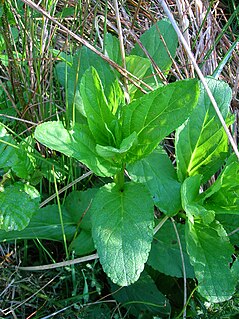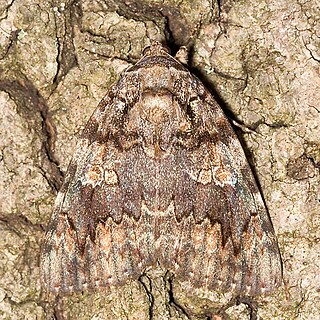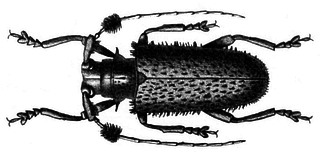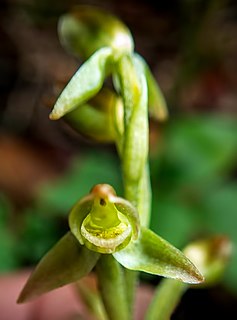
Eridge Green is a 8.4-hectare (21-acre) biological Site of Special Scientific Interest north-east of Crowborough in East Sussex. It is part of the 44 hectares Eridge Rocks nature reserve, which is managed by Sussex Wildlife Trust.

Scrophularia umbrosa, the green figwort, is a perennial herbaceous plant found in Europe and Asia. It grows in moist and cultivated waste ground.

Catocala umbrosa is a moth of the family Erebidae first described by Vernon Antoine Brou Jr. in 2002. It is found from Missouri and Louisiana east to Cuba and north through New Jersey to Canada.

Ercheia umbrosa is a species of moth of the family Erebidae. It is found in Japan, Korea, China and India.

The shadow darner is a species of dragonfly in the family Aeshnidae. It is found in almost all of Canada and most states in the United States.

Ceratarcha umbrosa is a moth in the family Crambidae described by Charles Swinhoe in 1894. It is found in Asia, including China, Taiwan and India.

Scedopla umbrosa is a species of moth of the family Erebidae first described by Wileman in 1916. It is found in Taiwan.

Aristobia approximator is a species of beetle in the Longhorn family. This species grows to 36mm.

Aristobia angustifrons is a species of beetle in the family Cerambycidae. It was described by Charles Joseph Gahan in 1888. It is known from Thailand, China and Myanmar.

Aristobia freneyi is a species of beetle in the family Cerambycidae. It was described by Schmitt in 1992. It is known from Thailand.

Aristobia hispida is a species of beetle in the family Cerambycidae. It was described by Saunders in 1853, originally under the genus Cerosterna. It is known from Taiwan, China and Vietnam.

Aristobia horridula is a species of beetle in the family Cerambycidae. It was described by Frederick William Hope in 1831, originally under the genus Lamia. It is known from Myanmar, Laos, Taiwan, China, Thailand, and Vietnam.
Aristobia laosensis is a species of beetle in the family Cerambycidae. It was described by Eric Jiroux, Philippe Garreau, Joan Bentanachs and Patrick Prévost in 2014. It is known from Laos.
Aristobia quadrifasciata is a species of beetle in the family Cerambycidae. It was described by Per Olof Christopher Aurivillius in 1916 and is known from Sumatra and Malaysia.
Aristobia tavakiliani is a species of beetle in the family Cerambycidae. It was described by Eric Jiroux, Philippe Garreau, Joan Bentanachs and Patrick Prévost in 2014. It is known from Malaysia.
Aristobia vietnamensis is a species of beetle in the family Cerambycidae. It was described by Stephan von Breuning in 1972. It is known from Vietnam.

Aristobia voeti is a species of beetle in the family Cerambycidae. It was described by James Thomson in 1878. Although the name was originally spelled as "voetii", this spelling was not in use between 1894 and 2014, and therefore the spelling "voeti" must be preserved under ICZN Article 33.3.1, as this is the spelling that is in prevailing usage. It is known from Laos, China and Myanmar.

Aristobia reticulator is a species of beetle in the family Cerambycidae. It is known from Bhutan, Myanmar, India, China, Laos, Bangladesh, Thailand, and Vietnam. It feeds on Prunus persica, Liquidambar formosana, Quercus acutissima, Prunus salicina, and Nephelium mutabile. Many references list the name as Aristobia testudo, but this name, though published earlier, is unavailable under the ICZN, primarily in that Johann Eusebius Voet's 1778 work giving the name testudo fails to fulfill the requirement in ICZN Article 11.4 that a work must be consistently binominal; none of Voet's 1778 names, including testudo, are available.

Goodyera umbrosa, commonly known as the native jade orchid or green jewel orchid, is a species of orchid that is endemic to northern Queensland where it grows in highland rainforest. It has between four and eight large, egg-shaped leaves and up to ten small pale green or pinkish flowers with the dorsal sepal and petals forming a hood over the column.

Saxifraga umbrosa, called true London pride, none-so-pretty, king's feather, kiss-me-quick, leaf of St Patrick, look-up-and-kiss-me, mignonette of the French, Nancy-pretty, prattling Parnell, Pyrenean saxifrage, sailor plant, St Anne's needlework, St Patrick's cabbage, and whimsey, although some of these names may more properly belong to Saxifraga spathularis, or its hybrid with S. spathularis, Saxifraga × urbium, is a species of flowering plant in the family Saxifragaceae. It is native to the Pyrenees, and has been introduced elsewhere in Europe, and to southern Chile. Its cultivar 'Clarence Elliott' has gained the Royal Horticultural Society's Award of Garden Merit.















